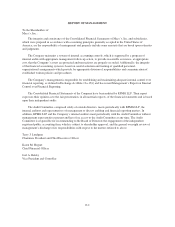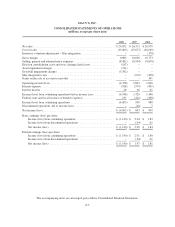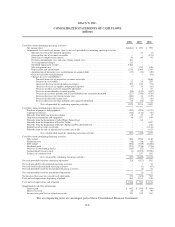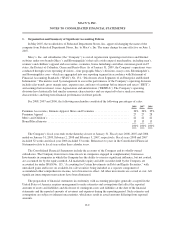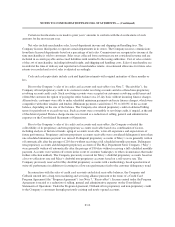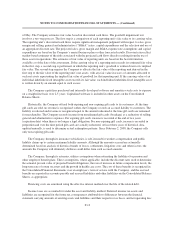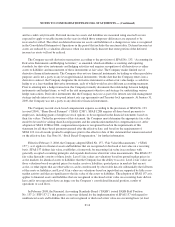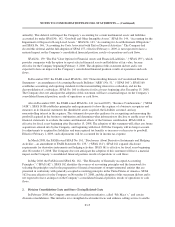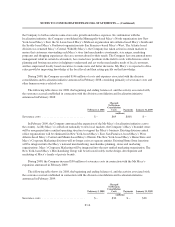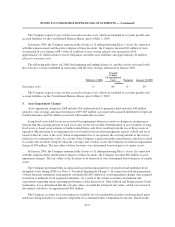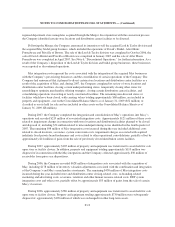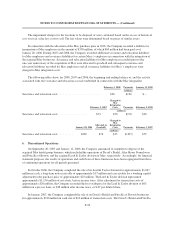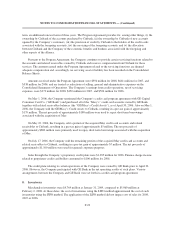Macy's 2008 Annual Report Download - page 60
Download and view the complete annual report
Please find page 60 of the 2008 Macy's annual report below. You can navigate through the pages in the report by either clicking on the pages listed below, or by using the keyword search tool below to find specific information within the annual report.
NOTES TO CONSOLIDATED FINANCIAL STATEMENTS — (Continued)
The arrangements pursuant to which the Company’s vendors provide allowances, while binding, are
generally informal in nature and one year or less in duration. The terms and conditions of these arrangements
vary significantly from vendor to vendor and are influenced by, among other things, the type of merchandise to
be supported.
Depreciation of owned properties is provided primarily on a straight-line basis over the estimated asset
lives, which range from 15 to 50 years for buildings and building equipment and 3 to 15 years for fixtures and
equipment. Real estate taxes and interest on construction in progress and land under development are capitalized.
Amounts capitalized are amortized over the estimated lives of the related depreciable assets. The Company
receives contributions from developers and merchandise vendors to fund building improvement and the
construction of vendor shops. Such contributions are netted against the capital expenditures.
Buildings on leased land and leasehold improvements are amortized over the shorter of their economic lives
or the lease term, beginning on the date the asset is put into use. The Company receives contributions from
landlords to fund buildings and leasehold improvements. Such contributions are recorded as deferred rent and
amortized as reductions to lease expense over the lease term.
The Company recognizes operating lease minimum rentals on a straight-line basis over the lease term.
Executory costs such as real estate taxes and maintenance, and contingent rentals such as those based on a
percentage of sales are recognized as incurred.
The lease term, which includes all renewal periods that are considered to be reasonably assured, begins on
the date the Company has access to the leased property.
The carrying value of long-lived assets is periodically reviewed by the Company whenever events or
changes in circumstances indicate that a potential impairment has occurred. For long-lived assets held for use, a
potential impairment has occurred if projected future undiscounted cash flows are less than the carrying value of
the assets. The estimate of cash flows includes management’s assumptions of cash inflows and outflows directly
resulting from the use of those assets in operations. When a potential impairment has occurred, an impairment
write-down is recorded if the carrying value of the long-lived asset exceeds its fair value. The Company believes
its estimated cash flows are sufficient to support the carrying value of its long-lived assets. If estimated cash
flows significantly differ in the future, the Company may be required to record asset impairment write-downs.
For long-lived assets held for disposal by sale, an impairment charge is recorded if the carrying amount of
the asset exceeds its fair value less costs to sell. Such valuations include estimations of fair values and
incremental direct costs to transact a sale. If the Company commits to a plan to dispose of a long-lived asset
before the end of its previously estimated useful life, estimated cash flows are revised accordingly, and the
Company may be required to record an asset impairment write-down. Additionally, related liabilities arise such
as severance, contractual obligations and other accruals associated with store closings from decisions to dispose
of assets. The Company estimates these liabilities based on the facts and circumstances in existence for each
restructuring decision. The amounts the Company will ultimately realize or disburse could differ from the
amounts assumed in arriving at the asset impairment and restructuring charge recorded. The Company classifies
a long-lived asset as held for disposal by sale when it ceases to be used and it is probable that a sale will be
completed within one year.
The carrying value of goodwill and other intangible assets with indefinite lives are reviewed at least
annually for possible impairment in accordance with SFAS No. 142 “Goodwill and Other Intangible Assets”
(“SFAS 142”). Goodwill and other intangible assets with indefinite lives have been assigned to reporting units
for purposes of impairment testing. The reporting units are the Company’s retail operating divisions. Goodwill
and other intangible assets with indefinite lives are tested for impairment annually at the end of the fiscal month
F-12


